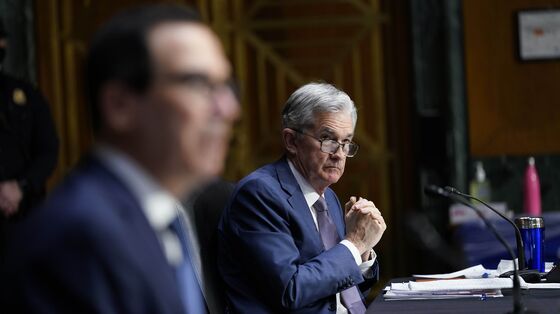Powell, Mnuchin Embrace New Stimulus After Fed Lending Rift
Powell, Mnuchin Embrace New Stimulus After Rift Over Fed Lending
(Bloomberg) -- Federal Reserve Chair Jerome Powell and U.S. Treasury Secretary Steven Mnuchin both backed more fiscal stimulus to bridge the economy through the next few months of the pandemic as the promise of Covid-19 vaccines looms.
“Some fiscal support now would really help move the economy along” and guard against downside risks, particularly to small businesses, Powell told the Senate Banking Committee Tuesday during a joint appearance with the Treasury chief. “The risk of overdoing it is less than the risk of under doing it.”

Mnuchin said he is speaking with the Republican leadership including President Donald Trump, about further stimulus, adding “I urge Congress to pass something quickly.”
Washington has gridlocked for months over providing additional fiscal aid, though a bipartisan group of lawmakers unveiled a new proposal Tuesday to break the stalemate. Rising virus cases threaten to restrain economic activity and slow the recovery at a time when millions of Americans are out of work and businesses struggle to hang on.
Powell gave no indication how the central bank may respond to the risk of fading economic momentum when it meets Dec. 15-16, though he reiterated that it would use all of its tools to help the economy recover.
“We do have a long way to go,” Powell said, pointing out that about 10 million people remain out of work. “We will use our tools until the danger has well and truly passed, but it may require help from other parts of the government as well, including Congress.”
The bipartisan group of senators proposed $908 billion of support, including $300 billion of forgivable loans for small businesses, $240 billion for state and local government and $180 billion to extend unemployment benefits. Neither Republican nor Democratic leadership has signed on to the plan.
Fed Programs
Powell and Mnuchin’s joint hearing was their first since they disagreed last month over the expiration of several emergency loan programs set up after the pandemic hit in March.
Fed officials including Powell had pushed for the extension of all the central bank’s lending facilities, saying they served as critical backstops and restored market confidence. Most of the funds are scheduled to expire Dec. 31.
Some of the programs have been sparsely used. These include the Main Street Lending Program, which supports bank lending to mid-sized companies, as well as facilities to aid the corporate bond market and the debt of cash-strapped municipalities.
Powell said no central banker would want to remove backstops in the midst of an emergency. He said facilities could be re-established with the Treasury’s Exchange Stabilization Fund serving as backstop against loss if necessary.
He was echoed later on Tuesday by Mary Daly, president of the San Francisco Fed.
“Those lending powers can’t be overlooked as being valuable to the economy,” Daly told reporters on a conference call. “ “Even when take-up of our facilities is low, it doesn’t mean that our facilities aren’t effective. They provide effective insurance.”
Mnuchin announced last month that those Fed programs must sunset at the end of December, and asked the central bank to return unused funding authorized for the programs by Congress.
The Fed responded -- in a rare public fracture between the two institutions -- that it “would prefer that the full suite of emergency facilities” remain as a backstop “for our still-strained and vulnerable economy.”
Even with the disagreement, Mnuchin praised Powell during the hearing and said the two had been speaking “constantly.”
Powell noted that the lowest paid were experiencing double-digit unemployment.
“These are not people with a lot of savings, or a lot of resources, or a lot of opportunities right now,” he said. “There are parts of the economy that really will need help, or that might need help, to get that last span of the bridge in place to get to the other side of the pandemic.”
©2020 Bloomberg L.P.